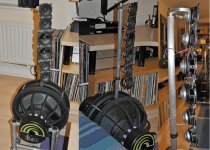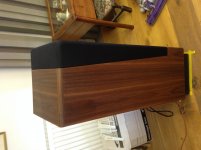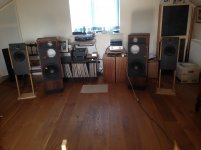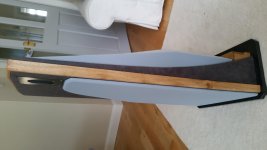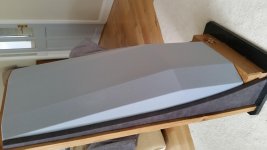I'm playing with the idea of building my first open baffle so naturally I am learning what I can from the usual sources. However, I have noticed some unexpected things on my journey and I'm curious to hear from others on these points:
1) Why do people keep the back of their open baffle speakers exposed? I am considering wrapping acoustically (very) transparent material around a simple think rear frame to create the visual effect of an enclosure. This would hide the 'ugly' parts from the wife, protect the drivers from prying fingers and protect the drivers from a build up of dust. The fabric layer would be easy to wash or to replace. Yet I have not seen a single person do this.
2) IMO, one of the two main reasons to go open baffle is the null which is created perpendicular to the axis of the speaker (wall to wall as well as ceiling to floor) and this works best with long wavelengths. So why is it that many people build open baffle midrange/treble speakers with ported/sealed bass enclosures? It seems to be throwing away a significant advantage of OB.
3) With reference again to the perpendicular nulls, this obviously works best when the radiation from the front and rear are symmetrical (except for the inverted polarity of course). Why do people therefore use frame profiles on bass drivers such as U or L which alter the front to rear symmetry? It seems that symmetrical profiles would offer an advantage here.
4) It surprises me to see people adding rear monopole tweeters to some designs. I would imagine that in most rooms, this energy would become so diffused and absorbed that I doubt it would add anything (except cost, complexity and weight). Personally, I strive to reduce room reverb as much as possible to allow me to hear the specific ambience and reverb of the recorded environment, not the reverb of my room. (I understand that some people are against dry rooms but I enjoy headphone listening due to the absence of room reverb.) I guess this one is just a matter of taste?
5) I don't see many people treating the wall behind the OB speakers for absorption or diffusion. Again, this would seem to add unnecessary room reverb and early reflections which would impact on detail and imaging. Is this generally a preference or are people simply overlooking the effect of room treatment?
6) Has anyone tried alternative baffle materials with success, e.g. constrained layer damping construction? Undamped and unbraced wood doesn't seem ideal but perhaps the resonance issues are negligible.
1) Why do people keep the back of their open baffle speakers exposed? I am considering wrapping acoustically (very) transparent material around a simple think rear frame to create the visual effect of an enclosure. This would hide the 'ugly' parts from the wife, protect the drivers from prying fingers and protect the drivers from a build up of dust. The fabric layer would be easy to wash or to replace. Yet I have not seen a single person do this.
2) IMO, one of the two main reasons to go open baffle is the null which is created perpendicular to the axis of the speaker (wall to wall as well as ceiling to floor) and this works best with long wavelengths. So why is it that many people build open baffle midrange/treble speakers with ported/sealed bass enclosures? It seems to be throwing away a significant advantage of OB.
3) With reference again to the perpendicular nulls, this obviously works best when the radiation from the front and rear are symmetrical (except for the inverted polarity of course). Why do people therefore use frame profiles on bass drivers such as U or L which alter the front to rear symmetry? It seems that symmetrical profiles would offer an advantage here.
4) It surprises me to see people adding rear monopole tweeters to some designs. I would imagine that in most rooms, this energy would become so diffused and absorbed that I doubt it would add anything (except cost, complexity and weight). Personally, I strive to reduce room reverb as much as possible to allow me to hear the specific ambience and reverb of the recorded environment, not the reverb of my room. (I understand that some people are against dry rooms but I enjoy headphone listening due to the absence of room reverb.) I guess this one is just a matter of taste?
5) I don't see many people treating the wall behind the OB speakers for absorption or diffusion. Again, this would seem to add unnecessary room reverb and early reflections which would impact on detail and imaging. Is this generally a preference or are people simply overlooking the effect of room treatment?
6) Has anyone tried alternative baffle materials with success, e.g. constrained layer damping construction? Undamped and unbraced wood doesn't seem ideal but perhaps the resonance issues are negligible.
My perspective (much influenced by having a fairly small listening room and limited by the number of things I have not tried and do not know):
1) I'm lazy, have no kids at home, and my speakers live in my den where my DW doesn't have to see them. For now at least, looks don't matter to me.
2) Everything is a compromise. Deep OB bass takes lots of speaker area & displacement (taking up a lot of room), and IME doesn't work all that well in a small space. I use sealed 12" woofers with DSP eq to cover from 200 down because it's easy and it works. What would it take to get to the mid 20's or lower with OB woofers in an 11' x 14' room?
3) Adding wings makes a slimmer visual profile and allows a little more extension from the driver. A u-frame or h-frame can also stand up on its own, and it's easy to build. The best dipole pattern would be from a naked driver, but also the least extension and the least LF output. Another compromise. If the wavelengths involved are several feet, how much of a problem are wings a few inches long? I'm not trying for deep bass, so my 12" midrange is on a fairly narrow flat baffle, but I have used u-frames on other builds.
4) More compromises. A front-only monopole tweeter means an unequal power response from front to back. Ideal reflections should have the same FR as the direct sound, but it's hard to get ideal dipole behavior from tweeters. Even the most experienced and well regarded designers (e.g. Linkwitz, Krekovsky) have gone back and forth on this. My current tweeter is a dipole but does not display ideal dipole radiation (ESS Heil AMT).
5) Absorption is never equally effective at all frequencies, so front-wall absorption would change the FR of the reflected sound. Maybe good, maybe not. I have resisted the temptation to put absorption on the wall behind the speakers for that reason, but then again I can be lazy and might just be justifying my inaction. 😀
I have bookshelves on the side walls that are irregular enough to provide some degree of diffusion. I have not tried actual scientifically-designed diffusors, but effective ones are large and deep and the lower in frequency they need to be effective the larger and deeper they get, and that would cut into my already-too-small room significantly. There's that justification for laziness again. 😉
I find that I like the spaciousness I get from OB speakers even in a room that's not generally regarded as ideal for them, as opposed to the drier, more direct sound of speakers with waveguide / horn tweeters. I use horns in my HT surround setup, where the ambiance comes from the rear channels.
6) Many baffle materials and approaches have been tried. IMO If the baffles are small enough, the materials should matter less given some minimum level of stiffness. Again, the ideal tends towards naked drivers - no baffle, no problem (as long as we can figure out how to hold the driver in place, and whole threads have been written about that)!
1) I'm lazy, have no kids at home, and my speakers live in my den where my DW doesn't have to see them. For now at least, looks don't matter to me.
2) Everything is a compromise. Deep OB bass takes lots of speaker area & displacement (taking up a lot of room), and IME doesn't work all that well in a small space. I use sealed 12" woofers with DSP eq to cover from 200 down because it's easy and it works. What would it take to get to the mid 20's or lower with OB woofers in an 11' x 14' room?
3) Adding wings makes a slimmer visual profile and allows a little more extension from the driver. A u-frame or h-frame can also stand up on its own, and it's easy to build. The best dipole pattern would be from a naked driver, but also the least extension and the least LF output. Another compromise. If the wavelengths involved are several feet, how much of a problem are wings a few inches long? I'm not trying for deep bass, so my 12" midrange is on a fairly narrow flat baffle, but I have used u-frames on other builds.
4) More compromises. A front-only monopole tweeter means an unequal power response from front to back. Ideal reflections should have the same FR as the direct sound, but it's hard to get ideal dipole behavior from tweeters. Even the most experienced and well regarded designers (e.g. Linkwitz, Krekovsky) have gone back and forth on this. My current tweeter is a dipole but does not display ideal dipole radiation (ESS Heil AMT).
5) Absorption is never equally effective at all frequencies, so front-wall absorption would change the FR of the reflected sound. Maybe good, maybe not. I have resisted the temptation to put absorption on the wall behind the speakers for that reason, but then again I can be lazy and might just be justifying my inaction. 😀
I have bookshelves on the side walls that are irregular enough to provide some degree of diffusion. I have not tried actual scientifically-designed diffusors, but effective ones are large and deep and the lower in frequency they need to be effective the larger and deeper they get, and that would cut into my already-too-small room significantly. There's that justification for laziness again. 😉
I find that I like the spaciousness I get from OB speakers even in a room that's not generally regarded as ideal for them, as opposed to the drier, more direct sound of speakers with waveguide / horn tweeters. I use horns in my HT surround setup, where the ambiance comes from the rear channels.
6) Many baffle materials and approaches have been tried. IMO If the baffles are small enough, the materials should matter less given some minimum level of stiffness. Again, the ideal tends towards naked drivers - no baffle, no problem (as long as we can figure out how to hold the driver in place, and whole threads have been written about that)!
My perspective ..
Thanks for sharing your thoughts. Maybe you should change your username to lazymusician? 😛
You are exactly right on many of these points. That is why I have arrived at this design.......
Just wait for the bass cancelling & comb filter guys to comment 😀

Just wait for the bass cancelling & comb filter guys to comment 😀
Attachments
Last edited:
That is cool.
What are you using for EQ, not just as far as passive vs active, but - do the drivers get any correction for OB cancellation, or is that part of the transition to the SLOB like woofers? I have a few Alpair 5.2's on closeout sale when the 5.3 came out
What are you using for EQ, not just as far as passive vs active, but - do the drivers get any correction for OB cancellation, or is that part of the transition to the SLOB like woofers? I have a few Alpair 5.2's on closeout sale when the 5.3 came out
Thanks for sharing your thoughts. Maybe you should change your username to lazymusician? 😛
Maybe if I was less lazy, I could have been a better musician. But I would never have been a good one!
That is cool.
What are you using for EQ, not just as far as passive vs active, but - do the drivers get any correction for OB cancellation, or is that part of the transition to the SLOB like woofers? I have a few Alpair 5.2's on closeout sale when the 5.3 came out
Woofers are actively driven using dedicated DSP amp.
There is no eq applied to array, apart HPF @ 200hz.
OB bass roll-off is compensated for by appropriate woofer cross-over.
Thank you lousy, very good synopis and I agree totally.
I too tested with different upper mid - treble systems. My lowest bass is monopole down from 150Hz. 4 ways and dsp are neeeded for a well balanced system! And lots of testing and tuning.
Dipoles need open space around and reflective surfaces. Baffle material and properties are rather irrelevant.
I too tested with different upper mid - treble systems. My lowest bass is monopole down from 150Hz. 4 ways and dsp are neeeded for a well balanced system! And lots of testing and tuning.
Dipoles need open space around and reflective surfaces. Baffle material and properties are rather irrelevant.
Woofers are actively driven using dedicated DSP amp.
There is no eq applied to array, apart HPF @ 200hz.
OB bass roll-off is compensated for by appropriate woofer cross-over.
That's good news, thanks!
Regarding distance to the back wall, this 40" tall (10 driver) array will sometimes be in a small truckbed shell that I'm insulating into a camper.. So I'm looking at the stuffed-tubes that SL did for the LXmini, giving cardiod response and the ability to put closer to the wall. They sounded amazing at BAF in 2015, a bunch of us were sure hearing sounds way past the speaker widths. I may start with Nelson's passve XO boards, not much room for a HQPlayer PC
What are the sources you have learned from?I'm playing with the idea of building my first open baffle so naturally I am learning what I can from the usual sources.
1) Why do people keep the back of their open baffle speakers exposed? I am considering wrapping acoustically (very) transparent material around a simple think rear frame to create the visual effect of an enclosure. This would hide the 'ugly' parts from the wife, protect the drivers from prying fingers and protect the drivers from a build up of dust. The fabric layer would be easy to wash or to replace. Yet I have not seen a single person do this.
So, i am also playing with OB, I agree with you, if i ever do it i would have grilles, perhaps like these, here attached is SL phoenix (copied from website and credit given here!) with nice simple cover, could be front and back in the same style even if this is not!!
Now i have built what i consider is a really nice sounding speaker, Troels Gravesen designed Fusion BAD, another pic attached and they sound very nice, so in Covid lockdown, the works of the Fusion have escaped and been set up as an OB experiment, mid and treble on the passive crossover and bass bins with the Hypex, with help from Fluid, poster on here i have set them up and they pique my interest to see if i might build OB to achieve the magic that SL describes, but actually the Fusions can also be difficult to beat...
Here attached a pic of the current state of the experiment, definitely has some appeal as an open sound, not smooth and integrated like the Fusion, but that's not surprising.
Attachments
1) Why do people keep the back of their open baffle speakers exposed? I am considering wrapping acoustically (very) transparent material around a simple think rear frame to create the visual effect of an enclosure. This would hide the 'ugly' parts from the wife, protect the drivers from prying fingers and protect the drivers from a build up of dust. The fabric layer would be easy to wash or to replace. Yet I have not seen a single person do this.
Well, now you have🙂 They were time consuming to make though.
I also agree with you about the need for tweeter rear radiation. I think it sounds better that way.
Attachments
Well, now you have🙂 They were time consuming to make though.
Oh, the front panel too! Good job and thanks for sharing. 🙂
My perspective (much influenced by having a fairly small listening room and limited by the number of things I have not tried and do not know):
4) More compromises. A front-only monopole tweeter means an unequal power response from front to back. Ideal reflections should have the same FR as the direct sound, but it's hard to get ideal dipole behavior from tweeters. Even the most experienced and well regarded designers (e.g. Linkwitz, Krekovsky) have gone back and forth on this. My current tweeter is a dipole but does not display ideal dipole radiation (ESS Heil AMT).
I agree with you.
I don't design by graphs, but by getting close with math, and then fine tuning audibly. As others frequently note, even a dipole tweeter doesn't add much audibly to the balance. I think this is due to the audio shadow of the baffle they are usually mounted on.
- Home
- Loudspeakers
- Multi-Way
- Some open baffle questions
